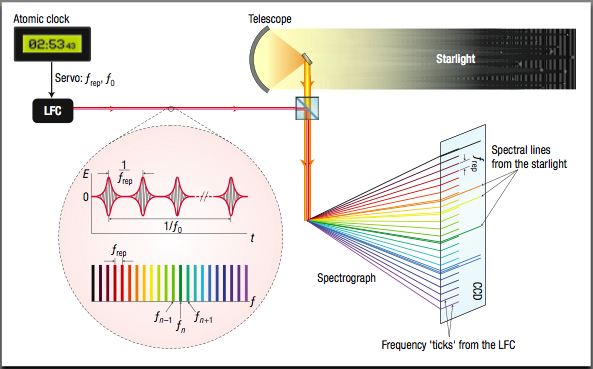The Laser Frequency Comb
One of the crucial subsystems of CODEX will be its wavelength calibration source. The spectrum of an ideal calibration source has a high density of unblended, regularly spaced lines of uniform intensity covering the entire spectral range of interest. The wavelengths of these lines should be known from first principles and they should remain stable and reproducible to high accuracy for many years.
Traditional methods of wavelength calibration struggle to meet the high demands of CODEX on accuracy and stability but recent developments in Quantum Optics and Laser Physics mean that a novel, nearly perfect calibration source should become available in time for the CODEX and E-ELT in form of the so-called laser frequency comb (LFC, Murphy et al. 2007, MNRAS, 380, 839).
The core of an LFC is a mode-locked laser emitting a repetitive train of femtosecond pulses (Udem et al. 2002, Nature, 416, 233) In frequency space this results in thousands of equally spaced modes. The mode spacing is given by the pulse repetition frequency which resides in the radio frequency domain. The repetition frequency can readily be synchronised with a precise radio frequency reference such as an atomic clock. These clocks provide by far the most precise measurements of time and frequency currently available, which are in turn the most reliably determined quantities in physics.
The novelty of the LFC and its tremendous benefit for many areas of Physics has been widely recognized with the award of the 2005 Nobel Prize in Physics to T. Hänsch and J. Hall for fundamental and pioneering work in the development of the optical frequency comb technique.
Development and testing of a prototype Laser Comb system for HARPS is under way in collaboration between ESO and the Max Planck Institute of Quantum Optics. The built-in stability and reproducibility of the LFC spectra ensure that any evolution in the distortions of the wavelength scale induced by the spectrograph or detector may be accurately tracked over essentially arbitrary timescales. Prototypes have been recently tested as in Steinmetz et al. (2008, Science, 321, 1335).
Figure 1.

Wavelength calibration with a Laser Frequency Comb (LFC). The LFC emits a periodic pulse train with a period of 1/frep. The associated optical spectrum shows a comb-like structure with a line-spacing of frep and an offset frequency fo. The two radio-frequencie frep and fo are phase locked to a reference signal such as an atomic clock. This ensures precise knowledge of the frequencies fn of every spectral line in the LFC. The illustration is taken from Thomas R. Schibli, "Frequency combs: Combs for dark energy", Nature Photonics, Volume 2, Issue 12, pp. 712-713 (2008).